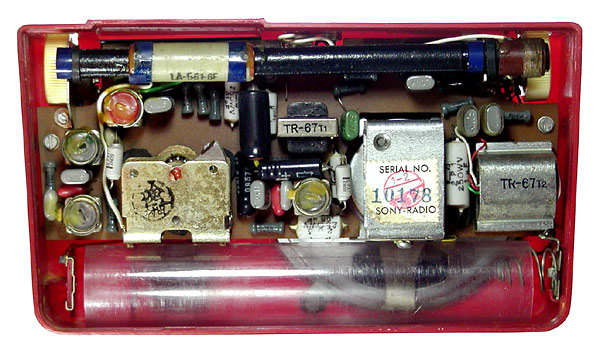
Sony TR-67


Sony TR-67

The TR-67 sports six transistors, two diodes, one varistor, and a big 3.5" speaker; it runs on three C-cell batteries and produces 110 mW of distortion-free output. Thanks partly to the introduction of Sony's new 2T7 series transistors at the beginning of 1958, this model is also said to have set a new sound quality standard for transistor radios. It is interesting to note, however, that early production units such as the one pictured above did not yet use these new transistors.
What's in the radio you see on this page:
Transistors: 2T512, 2T520, 2T524, 2T66, 2T64 x 2 [1T23 x 2, 1T41]
Circuit board revision: R-6F1a (radio built around November '57)For the sake of comparison, here's what I found in a TR-67 I restored last week:
Transistors: 2T74, 2T76 x 2, 2T66, 2T64 x 2 [1T23 x 2, 1T41]
Circuit board revision: R-6F2 (radio built around February '58)And a circuit diagram from a Japanese magazine printed in the spring of '58 shows this configuration:
Transistors: 2T74, 2T76 x 2, 2T66, 2T85 x 2 [1T23 x 2, 1T42]
Circuit board revision: n/aEvident here is the rapid speed with which Sony was moving to a whole new generation of transistors that featured higher performance and greatly improved production yields. In broader terms, it could be argued that the first half of 1958 coincides with the beginning of the true era of mass production for Japanese transistors and transistor radios.
Don't worry that the cabinet looks a bit bright and reddish in this photo. I had a backlight behind the radio and the semi-transparent quality of the cabinet plastic lets some of the light through. (You'll see this exaggerated on the next page!)